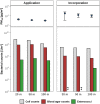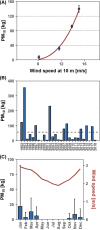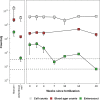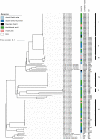Airborne bacterial emission fluxes from manure-fertilized agricultural soil
- PMID: 32697046
- PMCID: PMC7415373
- DOI: 10.1111/1751-7915.13632
Airborne bacterial emission fluxes from manure-fertilized agricultural soil
Abstract
This is the first study to quantify the dependence on wind velocity of airborne bacterial emission fluxes from soil. It demonstrates that manure bacteria get aerosolized from fertilized soil more easily than soil bacteria, and it applies bacterial genomic sequencing for the first time to trace environmental faecal contamination back to its source in the chicken barn. We report quantitative, airborne emission fluxes of bacteria during and following the fertilization of agricultural soil with manure from broiler chickens. During the fertilization process, the concentration of airborne bacteria culturable on blood agar medium increased more than 600 000-fold, and 1 m3 of air carried 2.9 × 105 viable enterococci, i.e. indicators of faecal contamination which had been undetectable in background air samples. Trajectory modelling suggested that atmospheric residence times and dispersion pathways were dependent on the time of day at which fertilization was performed. Measurements in a wind tunnel indicated that airborne bacterial emission fluxes from freshly fertilized soil under local climatic conditions on average were 100-fold higher than a previous estimate of average emissions from land. Faecal bacteria collected from soil and dust up to seven weeks after fertilization could be traced to their origins in the poultry barn by genomic sequencing. Comparative analyses of 16S rRNA gene sequences from manure, soil and dust showed that manure bacteria got aerosolized preferably, likely due to their attachment to low-density manure particles. Our data show that fertilization with manure may cause substantial increases of bacterial emissions from agricultural land. After mechanical incorporation of manure into soil, however, the associated risk of airborne infection is low.
© 2020 The Authors. Microbial Biotechnology published by Society for Applied Microbiology and John Wiley & Sons Ltd.
Conflict of interest statement
The authors declare no conflict of interest.
Figures








References
-
- Amato, P. , Joly, M. , Schaupp, C. , Attard, E. , Möhler, O. , Morris, C.E. , et al (2015) Survival and ice nucleation activity of bacteria as aerosols in a cloud simulation chamber. Atmos Chem Phys 15: 6455–6465.
-
- Anonymous (1986) Erste allgemeine Verwaltungsvorschrift zum Bundes‐Immissionsschutzgesetz – Technische Anleitung zur Reinhaltung der Luft (TA Luft) vom 7. Februar 1986. Gemeinsames Ministerialblatt (GMBl) G 3191: 95.
-
- Barberan, A. , Henley, J. , Fierer, N. , and Casamayor, E.O. (2014) Structure, inter‐annual recurrence, and global‐scale connectivity of airborne microbial communities. Sci Total Environ 487: 187–195. - PubMed
Publication types
MeSH terms
Substances
LinkOut - more resources
Full Text Sources

